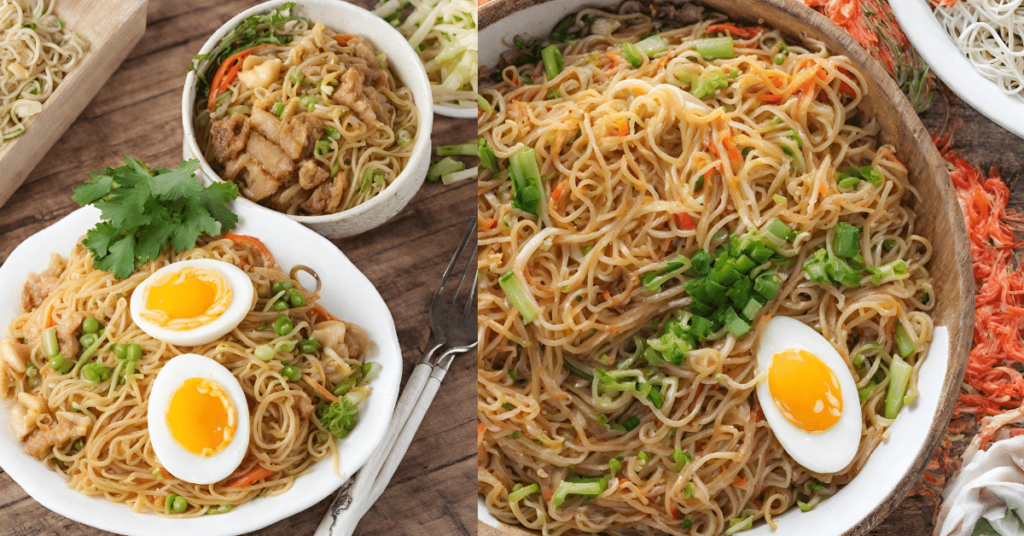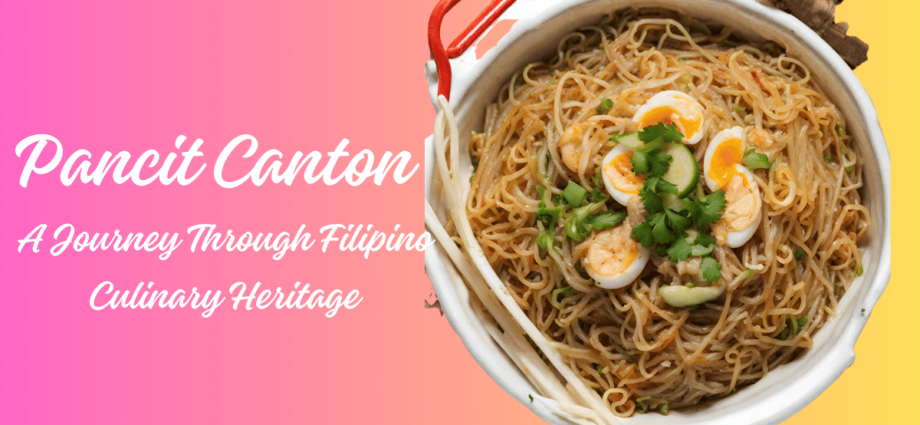Introduction
Prepare your taste buds for a culinary expedition that will transport you to the heart of Filipino cuisine. On our newest blog, we’re setting out on a flavorful adventure to uncover the history, origins, and cultural significance of Pancit Canton, a beloved Filipino noodle dish that’s rich in tradition.
Join us as we explore the fascinating story behind this iconic dish and learn how to recreate its magic in your own kitchen.
The Origins of Pancit Canton: A Culinary Odyssey
Pancit Canton’s roots can be traced back to the Filipino’s historical ties with Chinese traders who ventured to the archipelago long before the arrival of Spanish colonizers.
In fact, the word “Pancit” itself is derived from the Hokkien Chinese term “pian e sit,” which means “convenient food” or “fast food.”
Throughout centuries of cultural exchange, Chinese influences began to weave their way into the fabric of Filipino cuisine. This culinary cross-pollination gave birth to Pancit Canton, a dish that brilliantly marries Chinese noodle-making expertise with Filipino flavors and ingredients.
A Palate of Diversity: Pancit Canton’s Flavorful Medley
One of the most captivating aspects of Pancit Canton is its diverse and multifaceted palate.
The dish skillfully combines a plethora of ingredients and flavors, resulting in a harmonious blend that’s both satisfying and delicious.
Here are the key components that contribute to this delectable medley:
- Egg Noodles: Pancit Canton traditionally features thick egg noodles, which provide a satisfying chewiness and heartiness.
- Protein: It’s not uncommon to find a mix of chicken, pork, and shrimp in Pancit Canton, offering a delightful variety of tastes and textures.
- Soy Sauce: This essential ingredient imparts a savory and umami depth to the dish, infusing it with a rich, dark color.
- Oyster Sauce: Adding a subtle sweetness and a hint of umami, oyster sauce complements the soy sauce beautifully.
- Vegetables: The colorful array of bell peppers, carrots, and cabbage not only enhances the visual appeal but also provides a delightful crunch.
- Garlic: As with many Filipino dishes, minced garlic forms the aromatic foundation, infusing the dish with a fragrant base.
- Calamansi or Lemon: The zesty and citrusy brightness from calamansi or lemon juice lifts the flavors, providing a refreshing contrast.
- Sesame Oil: A touch of sesame oil adds a hint of nutty richness to the overall profile.
- Chili: For those who desire an extra kick, chili is often served on the side, allowing diners to adjust the level of heat to their liking.
You Might Also Be Interested: The Journey of Pad Thai: From Streets of Thailand to Your Plate

Crafting Pancit Canton: A Flavorful Odyssey
Now, let’s dive into the art of preparing Pancit Canton in your own kitchen. Follow these step-by-step instructions to create an authentic and mouthwatering rendition of this Filipino favorite:
Ingredients:
- 8 oz (about 225g) Pancit Canton noodles (or similar egg noodles)
- 1/2 cup chicken breast, thinly sliced
- 1/2 cup pork, thinly sliced
- 1/2 cup shrimp, peeled and deveined
- 2 cloves garlic, minced
- 1 small onion, chopped
- 1 carrot, julienned
- 1 bell pepper, thinly sliced
- 1 cup cabbage, shredded
- 2 tablespoons soy sauce
- 2 tablespoons oyster sauce
- 1 tablespoon calamansi or lemon juice
- 1 tablespoon sesame oil
- Salt and pepper to taste
- Cooking oil for stir-frying
Instructions:
- Prepare Noodles: Start by cooking the Pancit Canton noodles according to the package instructions. Once cooked, drain and set them aside.
- Stir-Fry Proteins: In a large wok or skillet, heat cooking oil over medium-high heat. Add the minced garlic and sauté until fragrant. Next, add the thinly sliced chicken, pork, and shrimp. Stir-fry until the proteins are no longer pink and the shrimp turns a vibrant pink color.
- Add Vegetables: Push the cooked proteins to one side of the wok, making room for the vegetables. Add the chopped onions, julienned carrots, and thinly sliced bell peppers. Stir-fry for a few minutes until the vegetables begin to soften and the colors brighten.
- Incorporate Noodles: Now, introduce the cooked Pancit Canton noodles to the wok, combining them with the proteins and vegetables.
- Sauce It Up: Drizzle the soy sauce, oyster sauce, and calamansi or lemon juice over the noodles. Toss everything together thoroughly, ensuring that the sauce evenly coats all the ingredients.
- Season and Finish: Season the Pancit Canton with salt and pepper to taste. Finally, add the sesame oil, which will impart a delightful nutty aroma. Toss in the shredded cabbage and stir-fry briefly until the cabbage wilts, and all the ingredients are well combined.
- Serve and Enjoy: Plate your Pancit Canton hot, garnishing it with sliced calamansi or lemon wedges for an extra burst of citrusy flavor. If you’re craving a bit of spice, consider serving it with chili on the side, allowing each diner to customize their level of heat.
Conclusion: Savor the Melody of Pancit Canton
Pancit Canton isn’t just a dish; it’s a symphony of flavors and a journey through Filipino culinary heritage.
From its Chinese-inspired beginnings to its modern Filipino adaptations, Pancit Canton reflects the dynamic and evolving nature of Filipino cuisine.
So, gather your ingredients, embark on this flavorful odyssey, and savor the melody of Pancit Canton in your own home. Enjoy!
You Might Also Like:
Exploring the Savory Delight of Bulalo: Origin, Flavor, and Recipe
Chicken Tikka Masala: A British Culinary Icon with an International Twist
Nasi Goreng with Egg: Unraveling the Indonesian Culinary Gem
Exploring the Flavorful Chicken Adobo: A Filipino Classic
Paksiw na Bangus: A Flavorful Filipino Classic
Crispy Fried Chicken Delight: A Filipino Favorite
- Top Digital Nomad Cities in Latin America (2026 Edition) - 15 December 2025
- Top Digital Nomad Cities in Europe (2026 Edition) - 14 December 2025
- Top Digital Nomad Cities in Asia (2026 Edition) - 14 December 2025











